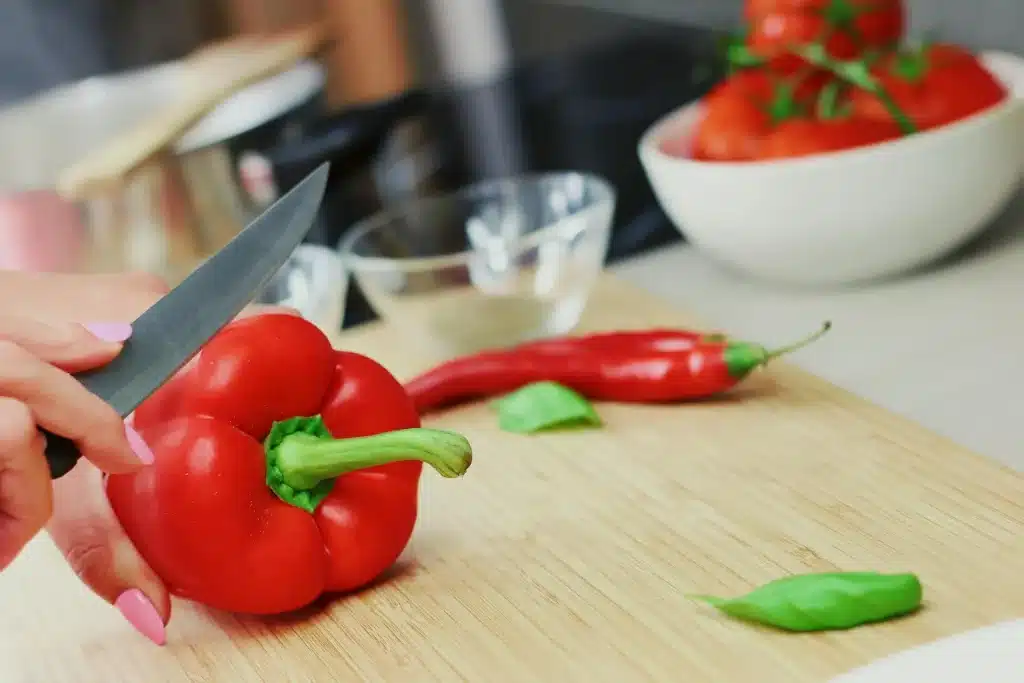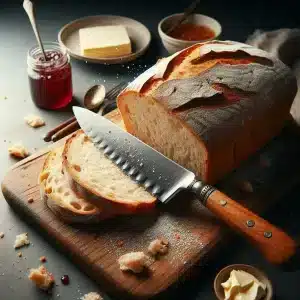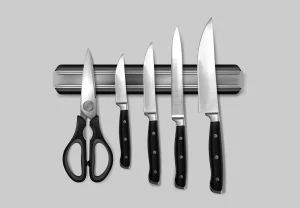When selecting a non-toxic cutting board, it’s essential to prioritize materials that do not leach harmful chemicals into your food. The best non-toxic cutting boards are made from natural materials like wood or bamboo, which are free from harmful chemicals such as BPA, phthalates, and formaldehyde.
Additionally, a high-quality non-toxic cutting board should be durable, resistant to knife marks, and easy to clean. The surface should not harbor bacteria, ensuring food safety, and the board should be easy to maintain with regular oiling or conditioning to prolong its life.
Types of cutting boards
Bamboo cutting boards
Bamboo cutting boards have gained popularity due to their sustainable and eco-friendly nature. Bamboo is a renewable resource that grows rapidly, making it an excellent choice for environmentally conscious consumers. It is also denser and harder than many other woods, which means it is resistant to scratches and knife marks.
Bamboo boards, like the 15-inch by 21-inch Bamboo Wood Cutting Board with Red Non-slip Corners are lightweight and easy to handle, and their smooth surface makes them easy to clean. However, regular oiling is necessary to prevent cracking and to maintain its non-toxic properties. Bamboo is naturally antimicrobial, making it a hygienic choice for food preparation.
Acacia wood cutting boards
Acacia wood cutting boards, like the Acacia Wood Chopping Board are known for their durability and beautiful grain patterns. Acacia wood is naturally resistant to water, which makes it less prone to warping or cracking compared to other types of wood. Its hardness ensures that it can withstand heavy cutting without showing wear easily.
The natural oils in acacia wood also provide some resistance to bacteria, though it still requires regular cleaning and oiling to maintain its non-toxic qualities. Acacia boards are ideal for those looking for a balance of aesthetics, durability, and safety in their kitchen.
Plastic cutting boards
Plastic cutting boards, while not typically regarded as non-toxic, are still widely used in kitchens due to their affordability and convenience. High-density polyethylene (HDPE) plastic boards are often considered a safer choice among plastics because they do not contain harmful chemicals like BPA. However, plastic boards tend to accumulate knife marks over time, which can harbor bacteria and make them more challenging to clean. Unlike wood or bamboo, plastic does not have natural antimicrobial properties, making proper sanitation critical. Though plastic boards can be dishwashed, they may need replacement more frequently than their wood or bamboo counterparts.
Glass cutting boards
Glass cutting boards are another popular option, known for their sleek appearance and easy cleaning. They are entirely non-porous, meaning they do not absorb liquids or bacteria, which makes them very hygienic. However, glass boards are hard on knives, quickly dulling their edges, and they can also be prone to breaking or chipping. While they do not contain harmful chemicals, they are generally not recommended for heavy-duty cutting tasks. Glass cutting boards are better suited for presentation purposes or light chopping.
Characteristics of the best non-toxic cutting boards
When searching for the best non-toxic cutting boards, here are key characteristics to look for:
1. Material: Opt for boards made from natural, sustainable materials like bamboo or wood, such as acacia. These are free from harmful chemicals like BPA, phthalates, and formaldehyde.
2. Durability: The board should resist knife marks and not crack easily. Bamboo and acacia are both durable options.
3. Antimicrobial Properties: Materials like bamboo and wood have natural antimicrobial properties, helping to reduce bacteria build-up.
4. Maintenance: Non-toxic cutting boards need regular oiling to maintain their surface. Look for boards that are easy to maintain with food-safe oils.
5. Eco-friendliness: Bamboo, in particular, is a renewable resource, making it a great option for those seeking an environmentally friendly product.
What to look for in a good non-toxic cutting board
Choosing the right non-toxic cutting board requires careful consideration of several factors:
1. Size and thickness: A good cutting board should have enough surface area to handle your typical food prep needs. Thicker boards tend to be more durable and less prone to warping.
2. Weight: Lightweight boards, like the 3-Piece Kitchen Cutting Board Set are easier to handle and store. However, heavier boards provide more stability during cutting.
3. Slip-resistance: Boards with non-slip edges, such as the [Bamboo Wood Cutting Board with Red Non-Slip Corners](https://sylarb.com/15-inch-by-21-inch-bamboo-wood-cutting-board-with-red-non-slip-corners/), provide better safety by staying in place while you chop.
4. Ease of cleaning: Non-toxic cutting boards should be easy to clean with mild soap and water. Some, like bamboo boards, may require occasional oiling to keep their surface smooth and bacteria-free.
5. Multifunctionality: Look for cutting boards that can serve multiple purposes, such as chopping, serving, and even decorative displays. Boards that are reversible or come in sets can add versatility to your kitchen.
Frequently Asked Questions
1. What is the safest material for a cutting board?
Wood and bamboo are considered the safest materials for cutting boards. They are free from harmful chemicals and have natural antimicrobial properties. Bamboo, in particular, is an eco-friendly and durable choice, while wood like acacia offers a balance of beauty and functionality.
2. How do I maintain a bamboo cutting board?
To maintain a bamboo cutting board, clean it with warm, soapy water after each use and dry it immediately. Periodically apply a food-safe mineral oil to prevent cracking and maintain its non-toxic properties. Avoid submerging bamboo boards in water or placing them in the dishwasher.
3. Are plastic cutting boards non-toxic?
While some plastic cutting boards are made from food-safe materials like high-density polyethylene (HDPE), they are not as naturally non-toxic as wood or bamboo. Over time, plastic boards develop deep knife grooves that can harbor bacteria, requiring more frequent replacement.
4. Can I use a glass cutting board for all types of food preparation?
Glass cutting boards are safe to use, but they are not ideal for heavy-duty chopping. They are hard on knives, quickly dulling their edges. Glass boards are better suited for light cutting or as presentation boards for serving food.
5. Which cutting board material is the most eco-friendly?
Bamboo is considered the most eco-friendly cutting board material due to its rapid regrowth and sustainability. Bamboo cutting boards, like the Bamboo Cutting Board Set are durable and environmentally friendly, making them an excellent choice for green-conscious consumers.
6. How often should I oil a wood or bamboo cutting board?
You should oil your wood or bamboo cutting board every 3-4 weeks or when it starts to feel dry. Use a food-safe mineral oil to keep the board conditioned and prevent it from cracking or warping.
7. Are bamboo cutting boards dishwashers safe?
No, bamboo cutting boards should not be placed in the dishwasher. The high heat and prolonged water exposure can cause the bamboo to warp or crack. Hand wash with mild soap and water for the best care.
8. How can I prevent my cutting board from slipping during use?
Some cutting boards come with non-slip corners or edges, like the Bamboo Cutting Board with Non-Slip Corners If your board does not have these, you can place a damp cloth or non-slip mat underneath the board to keep it stable during use.





